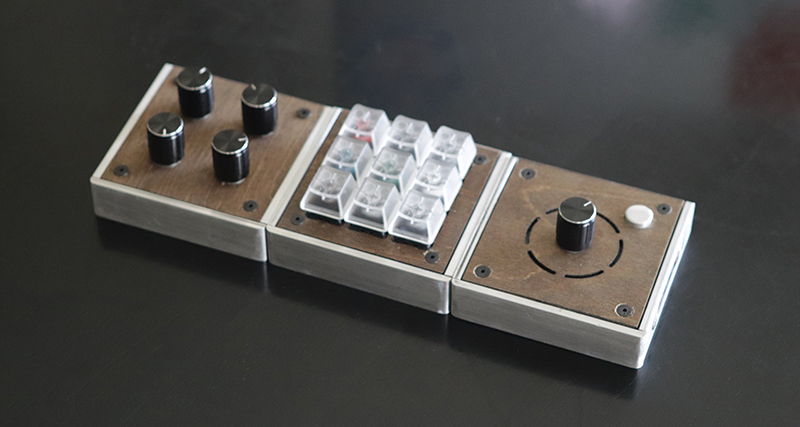Of all the input devices, the keyboard is the greatest. This comes at a cost, though: there were times back in the Before Days, when video and music editing applications came with custom keyboards. There were Pro Tools keyboards, Final Cut keyboards, and innumerable Adobe keyboards. What’s the solution to this problem? More keyboards, obviously, and this time we’ll make them modular.
For his Hackaday Prize entry, [Cole B] is building modular, programmable USB keyboards. It’s got everything: a standard 3×3 keypad, a keyboard that’s just four potentiometers, a keyboard that’s a rotary encoder, and a keyboard that’s a set of faders.
The design of these keyboards is inherently modular, and that means there needs to be a way to connect all these modules together, preferably without a bunch of USB cables strewn about. Right now, the best idea [Cole] is working with is pogo pins and magnets. It’s a great idea although Apple Thinks Differently™ and probably wouldn’t be too keen on seeing the whole ‘magnets and pins’ idea stolen out from under them.
Nevertheless, it’s an excellent project that shows how far you can go with manufacturing on a limited budget. These are fantastic keyboard modules already, and the connector scheme already pushes this project into the upper echelon of keyboard hacks.



















Haven’t pogo pins and magnets been used for decades on british tea kettles?
Eh? Have they?
Not on any kettle I ever saw over my several decades. Here, we call the power lead in the back of the PC a “kettle lead”. Although the heat-rated version used in actual kettles has a little notch cut out in the bottom-middle, so a kettle lead will power a PC but a PC lead won’t power a kettle, since it might well melt.
I can’t think how you’d make pogo pins safe for mains voltages, and they also seem like they’d be a bit crap for current, too. Our kettles are 240V 13A so something like 3KW, because tea is serious business over here.
They are standard on some appliances, though I remember the Asian market being the ones who originated it.
A quick Google search found me one such plug on Amazon: https://www.amazon.com/Presto-09982-Magnetic-Select-Models/dp/B000EPKB3W
Apple doesn’t have exclusive rights to magnetically latched connectors with spring loaded contact pins… that would be crazy. Common ebike connectors work similarly, not to mention the hugely popular educational toys “littlebits”
https://www.littlebits.com/
We can go further back than that. Magnets and the equivalent of pogo pins were used by the UK Home Office to provide a snatch-disconnect headset connector on Police motorcycle radios, when said radios were filled with valves (vacuum tubes).
Bulls…… Apple inventet everything…. ! It’s a God hand !
It doesn’t matter what is right or wrong. What matters is what everybody believes to be right or wrong.
Let me explain:
As long as nobody hears about the other concepts but are flooded by the commercials and advertisements about the “latest and greatest” achievements of some company then people soon start to think that that company is the first doing that. And if nobody tells the public otherwise it will eventually become “true” and even starts to make sense from all different sort of viewpoints. That something is still historically incorrect from then on no longer seems to matter to some.
Therefore it is important to hear about the kettle, the headphone connectors, etc.
Yet another example that history is written by wieners.
This seems very similar to https://palettegear.com/ (full disclosure: I have a set).
The resemblance is uncanny
Really interesting ideas and piece of tech! I’ll have to read more about this when I get a chance.
like the idea. though i think id want something more robust than magnetic connections and pogo pins. say i wanted a module with a full size joystick, is that little magnet going to keep the thing together when i need to do a hard maneuver in my flight sim. id rather have high quality connectors and hard bolt on linkages between units.
You could keep the magnetic connectors. But for robust setup you could have a screwhole and key holes on the bottom. You can then screw the modules to a platform, which could also be a module.
that would probibly be a good compromise.
If you take the springs out of the equation, in the 60s and 70s we had Lectron. https://en.wikipedia.org/wiki/Raytheon_Lectron